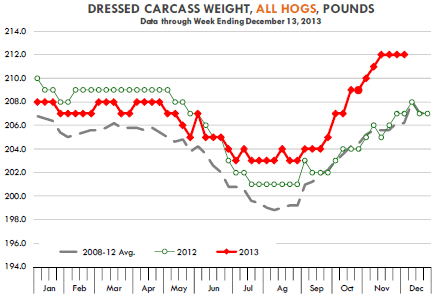



CME: Producers' Push to Increase Hog Weights Benefits Pork Production
US - Biological lags will continue to constrain livestock expansion in 2014 even as lower feed costs certainly provide an incentive for producers to bring more product to market, write Steve Meyer and Len Steiner.Pork production has benefited significantly from a push by producers to rapidly increase hog weights even as some hogs were lost due to PEDv virus last summer.
USDA pegged the average hog carcass weight last week at 212 pounds. This is an estimate and we think USDA will revise this number higher once all the data is compiled (revised numbers are published with a two week lag).
The Mandatory Price Reporting system pegs average hog carcass weights at 213.4 pounds last week, up 3.2 per cent from a year ago. Hog slaughter for the week was up 0.6 per cent, which implies that total pork production for the week was over 4 per cent last week.
The weight of producer owned hogs averaged 211.6 pounds (+2.9 per cent) while the average carcass weight of packer owned hogs was 218.3 pounds, +3.7 per cent higher than a year ago.
It is not unusual for packer owned hogs to be heavier at this time of year but the magnitude of the increase is unprecedented. The increase in weights has more than offset the declines due to PEDv.
Much of the discussion on PEDv has focused on the potential decline in hog numbers. So far, packers and producers have demonstrated that they can offset much/all of this through weight increases.
Hog weight performance and the potential expansion of the sow herd present the biggest wild cards for pork supply expansion, especially in the second half of 2014.









